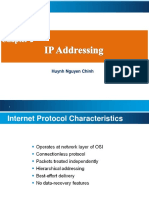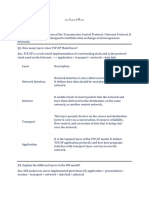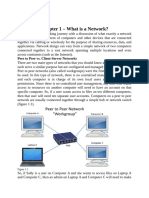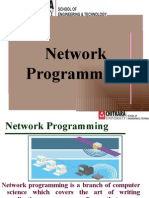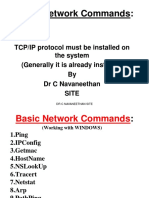Slides Java Networking With Channels Reactive Programming and Virtual Threads Networking Terminology
Uploaded by
abdullahibrahimothmanSlides Java Networking With Channels Reactive Programming and Virtual Threads Networking Terminology
Uploaded by
abdullahibrahimothmanWhat Is Networking?
Networking is the foundation of modern communications.
A network is a system of computers and other devices connected together, so that
they communicate with each other, to exchange data and share resources.
Networking refers to how the connected computers communicate.
This can be done over the internet, or over a local area network, which is just a
collection of devices, connected together in one physical location.
COMPLETE JAVA MASTERCLASS
Networking Terminology
Why is networking important in software
development?
Important reasons for networking:
• Data Communication, allowing applications to exchange data in real-time,
between users and systems.
• Distributed Systems, allowing applications to be deployed across many servers.
• Foundational for Internet and Cloud Computing.
• Enables Remote Access, and Control, to distributed systems.
• Enables communication between applications, through the use of APIs and Web
Services.
COMPLETE JAVA MASTERCLASS
Networking Terminology
Private Network (Intranet)
Computers may also communicate across a private network, also known as an
intranet.
In fact, that's where networking actually began, and intranets are still common
today in business.
COMPLETE JAVA MASTERCLASS
Networking Terminology
The Host
A host refers to any hardware device capable of participating in network
communication.
A common networking configuration that you've probably heard of is client server.
This means that one or more hosts on the network are acting as servers, and the
other hosts are clients that connect to the server.
COMPLETE JAVA MASTERCLASS
Networking Terminology
What's a client?
Clients are end-user devices or applications, that request services or resources from
servers.
They initiate communication with the servers, and rely on them, to fulfill specific
requests.
COMPLETE JAVA MASTERCLASS
Networking Terminology
What's a server?
Servers are usually powerful computers or software applications, that provide
services or resources to clients.
They listen for incoming requests from clients, process those requests, and respond
with the appropriate data or action.
COMPLETE JAVA MASTERCLASS
Networking Terminology
What's a client-server model?
Communication between the user's devices, and servers responding to their
requests, is called the client-server model.
This is a very common networking model, used in many different applications,
including web applications, email, file sharing and gaming.
Web browsing is a classic example, where the web browser (the client) sends
requests to web servers, and the servers respond by sending back web pages,
images, or other resources.
COMPLETE JAVA MASTERCLASS
Networking Terminology
Client-server applications can run on a single host
As I mentioned, you can have a client server interaction on the same host.
For example, the MySQL database comes with software we've been using called
MySQL Workbench.
The workbench is the client, and it connects to the MySQL database server on that
local host.
It could also connect remotely to another server if needed as well.
COMPLETE JAVA MASTERCLASS
Networking Terminology
How do the client and server communicate?
Clients and Servers communicate through several layers of protocols.
The lowest level is the network layer, which uses addresses to facilitate network
communication.
On top of this, is the data transport layer.
COMPLETE JAVA MASTERCLASS
Networking Terminology
The Port
When data arrives at the one physical connection to the network, it gets routed to
the target application through a port.
Each application that needs data from the network is assigned a port.
This includes clients connecting to a server, that's on the same machine.
When data arrives, the port number is used to route the data, for the specific
application that's waiting for it.
A port number is a positive integer between 0 and 65535.
COMPLETE JAVA MASTERCLASS
Networking Terminology
The IP Address
Every host connected to the Internet also has a unique IP address, including yours.
IP stands for Internet Protocol.
This describes the destination, or where the data is supposed to go in the network,
and it does it with an IP address.
COMPLETE JAVA MASTERCLASS
Networking Terminology
IPv4 vs. IPv6
IPv4 stands for Internet Protocol Version 4, and IPv6 stands for Internet Protocol
Version 6.
Once upon a time, there were only IPv4 addresses.
IPv4 uses a 32-bit address scheme, that allows for over 4 billion unique addresses.
Now that we've got computers, tablets, game consoles, smart TVs, smartphones,
smart appliances, four billion IP addresses wasn't really enough, and so IPv6 was
born.
COMPLETE JAVA MASTERCLASS
Networking Terminology
IPv6
IPv6 uses a 128-bit address scheme, which allows for many more IP addresses, than
IPv4 does.
Many Internet Service Providers, provide both IPv4 and IPv6 addresses to their
customers.
This ensures compatibility with older and newer technologies.
For example, new routers support IPv6, but if you're hanging onto an older router, it
may not. Or your ISP may only provide IPv4 addresses. Or you just have it
configured that way. As is the case for me, here.
COMPLETE JAVA MASTERCLASS
Networking Terminology
How do the client and server communicate?
The data transfer layer provides different protocols for transferring data.
In this section, I'll cover the TCP and UDP protocols.
These two protocols are still widely used by client server applications.
Feature Transmission Control Protocol (TCP) - 1974 User Datagram Protocol (UDP) - 1980
Connection Type Connection-oriented Connectionless
Reliability Highly reliable Unreliable
Category Stream of Data Datagram (or Data Packet)
Error Checking Yes No
Overhead Higher Lower
Speed Slower Faster
online gaming, streaming media, voice/video
Use Cases Web browsing, email, file transfer
over IP, real-time data feeds
COMPLETE JAVA MASTERCLASS
Networking Terminology
TCP/IP
TCP IP describes both the networking and data transport layers used.
It refers to using the TCP protocol for transferring data, over a network of IP
addresses.
Two applications running on the same host can still use TCP IP to communicate with
each other.
When the client and server are on the same host, usually the IP address, 127.0.0.1,
which is also referred to as the local host, is used to identify the host.
COMPLETE JAVA MASTERCLASS
Networking Terminology
Networking packages
Java Networking types can be split roughly
into two groups, low level APIs, which
work with sockets and network addresses,
and high level API types, that abstract
connectivity, with the use of such types as
URLs, Http Connections, and Http Clients.
In addition, the java.nio package offers an
alternative communication mechanism, in
the form of channels.
When using the low level API, you have to
be more aware of networking concepts.
COMPLETE JAVA MASTERCLASS
Networking Terminology
Sockets
When using the low level networking API, you'll use sockets to establish
connections, send requests, and receive responses.
A socket is one end point of the two-way connection.
The client will have a socket, and the server will also have a socket.
When you have multiple clients connecting to the same server, they'll use the same
port, but each client will have its own socket.
You'll use the Socket class for the client socket, and the ServerSocket class for the
server socket.
COMPLETE JAVA MASTERCLASS
Networking Terminology
Overview
Since we're talking about networking, we're going to have to write two applications
to demonstrate how to do networking coding.
One application will be the server, and the other will be the client.
COMPLETE JAVA MASTERCLASS
Networking Terminology
You might also like
- Networking Concepts For DevOps Engineers 170132099No ratings yetNetworking Concepts For DevOps Engineers 17013209911 pages
- Client-Server Network: Local Area Networks (Lans) FTP DnsNo ratings yetClient-Server Network: Local Area Networks (Lans) FTP Dns8 pages
- Technology Infrastructure - Notes From Chapter 2No ratings yetTechnology Infrastructure - Notes From Chapter 240 pages
- ITEC3116-SNAL-Lecture 16 - Linux Server ConfigurationNo ratings yetITEC3116-SNAL-Lecture 16 - Linux Server Configuration24 pages
- CS 556: Distributed Systems: FundamentalsNo ratings yetCS 556: Distributed Systems: Fundamentals45 pages
- Lesson 02 - Introduction To Web DevelopmentNo ratings yetLesson 02 - Introduction To Web Development14 pages
- Socket-Programming-Fundamentals-and-ApplicationsNo ratings yetSocket-Programming-Fundamentals-and-Applications10 pages
- Computer Network and Security Full Note 2No ratings yetComputer Network and Security Full Note 2203 pages
- Lecture 1 Introduction To Web ApplicationsNo ratings yetLecture 1 Introduction To Web Applications11 pages
- Internet: World Wide Web WWW and Commonly Known As The Web, Is A System ofNo ratings yetInternet: World Wide Web WWW and Commonly Known As The Web, Is A System of10 pages
- CP4153-Network Technologies unit 1 2021No ratings yetCP4153-Network Technologies unit 1 202134 pages
- IT Networking Engineer Interview QuestionsNo ratings yetIT Networking Engineer Interview Questions3 pages
- IT Networking Engineer Interview Questions, Answers and TipsNo ratings yetIT Networking Engineer Interview Questions, Answers and Tips3 pages
- Himashu Kumar Singh 3 Year B.Tech (CSE) NormalNo ratings yetHimashu Kumar Singh 3 Year B.Tech (CSE) Normal25 pages
- Wireless / Networking: Introduction To Client Server NetworksNo ratings yetWireless / Networking: Introduction To Client Server Networks5 pages
- Week 4 Application Layer Without VideosNo ratings yetWeek 4 Application Layer Without Videos45 pages
- Slides Concurrency Additional Thread Pools Callable Submit and the FutureNo ratings yetSlides Concurrency Additional Thread Pools Callable Submit and the Future4 pages
- Slides Concurrency Managing Threads Introduction to the ExecutorService SingleThreadExecutorServiceNo ratings yetSlides Concurrency Managing Threads Introduction to the ExecutorService SingleThreadExecutorService4 pages
- Slides Concurrency the FixedThreadPool ExecutorServiceNo ratings yetSlides Concurrency the FixedThreadPool ExecutorService4 pages
- Slides Concurrency ExecutorService ChallengeNo ratings yetSlides Concurrency ExecutorService Challenge1 page
- Slides Concurrency WorkStealingPool ForkJoinPoolNo ratings yetSlides Concurrency WorkStealingPool ForkJoinPool3 pages
- Slides Input & Output (IO) Working With Files in Java Exception Handling Checked vs Unchecked the Finally ClauseNo ratings yetSlides Input & Output (IO) Working With Files in Java Exception Handling Checked vs Unchecked the Finally Clause9 pages
- Slides Input & Output (IO) Working With Files in Java Exception Handling Try With ResourcesNo ratings yetSlides Input & Output (IO) Working With Files in Java Exception Handling Try With Resources2 pages
- Slides Java Networking With Channels Reactive Programming and Virtual Threads Introduction to Java NetworkingNo ratings yetSlides Java Networking With Channels Reactive Programming and Virtual Threads Introduction to Java Networking3 pages
- Slides Java Networking With Channels Reactive Programming and Virtual Threads Creating a Simple Client Server Connection Using ServerSocket (1)No ratings yetSlides Java Networking With Channels Reactive Programming and Virtual Threads Creating a Simple Client Server Connection Using ServerSocket (1)2 pages
- Ccna Cybersecurity Operations (Version 1.1) - Cyberops Chapter 4 Exam Answers 2019No ratings yetCcna Cybersecurity Operations (Version 1.1) - Cyberops Chapter 4 Exam Answers 201913 pages
- Chapter 2 - Communicating Over The Network: CCNA Exploration 4.0No ratings yetChapter 2 - Communicating Over The Network: CCNA Exploration 4.043 pages
- ADVENT OF POPULAR MEDIA (Himanshu Dhariwal)0% (1)ADVENT OF POPULAR MEDIA (Himanshu Dhariwal)41 pages
- Asante FriendlyNET GX6-2400W-User ManualNo ratings yetAsante FriendlyNET GX6-2400W-User Manual55 pages
- Network Assessment Checklist - NSE4 Exam PDFNo ratings yetNetwork Assessment Checklist - NSE4 Exam PDF19 pages
- Huawei CloudEngine 16800 Switch Datasheet (V3)No ratings yetHuawei CloudEngine 16800 Switch Datasheet (V3)16 pages
- User Plane and Control Plane Separation Framework For Home Base StationsNo ratings yetUser Plane and Control Plane Separation Framework For Home Base Stations8 pages
- Troubleshooting Guide For Cisco Unified Call Manager, Release 5No ratings yetTroubleshooting Guide For Cisco Unified Call Manager, Release 5162 pages
- 2VAA002993 en S Control and IO Symphony Plus Ethernet Networking100% (1)2VAA002993 en S Control and IO Symphony Plus Ethernet Networking18 pages
- Networking Basics: Chapter 04 Networking in JavaNo ratings yetNetworking Basics: Chapter 04 Networking in Java42 pages
- Site To Site VPN With Dynamic Crypto MapNo ratings yetSite To Site VPN With Dynamic Crypto Map7 pages
- Networking Fundamentals: Selected ConceptsNo ratings yetNetworking Fundamentals: Selected Concepts32 pages
- HC12011A011 VRRP Principle and ConfigurationNo ratings yetHC12011A011 VRRP Principle and Configuration45 pages
- Software-Defined Access: Solution Design GuideNo ratings yetSoftware-Defined Access: Solution Design Guide43 pages
- Configurar Mitsubishi - SR-1000 - SR-X - SR-2000 - CM - C96GB - WW - GB - 2022 - 1No ratings yetConfigurar Mitsubishi - SR-1000 - SR-X - SR-2000 - CM - C96GB - WW - GB - 2022 - 17 pages
- NetEngine 8000 M4 Universal Service Router DatasheetNo ratings yetNetEngine 8000 M4 Universal Service Router Datasheet18 pages
- Networking Concepts For DevOps Engineers 170132099Networking Concepts For DevOps Engineers 170132099
- Client-Server Network: Local Area Networks (Lans) FTP DnsClient-Server Network: Local Area Networks (Lans) FTP Dns
- ITEC3116-SNAL-Lecture 16 - Linux Server ConfigurationITEC3116-SNAL-Lecture 16 - Linux Server Configuration
- Internet: World Wide Web WWW and Commonly Known As The Web, Is A System ofInternet: World Wide Web WWW and Commonly Known As The Web, Is A System of
- IT Networking Engineer Interview Questions, Answers and TipsIT Networking Engineer Interview Questions, Answers and Tips
- Wireless / Networking: Introduction To Client Server NetworksWireless / Networking: Introduction To Client Server Networks
- REMOTE ACCESS VPN- SSL VPN: A deep dive into SSL VPN from basicFrom EverandREMOTE ACCESS VPN- SSL VPN: A deep dive into SSL VPN from basic
- Slides Concurrency Additional Thread Pools Callable Submit and the FutureSlides Concurrency Additional Thread Pools Callable Submit and the Future
- Slides Concurrency Managing Threads Introduction to the ExecutorService SingleThreadExecutorServiceSlides Concurrency Managing Threads Introduction to the ExecutorService SingleThreadExecutorService
- Slides Concurrency the FixedThreadPool ExecutorServiceSlides Concurrency the FixedThreadPool ExecutorService
- Slides Input & Output (IO) Working With Files in Java Exception Handling Checked vs Unchecked the Finally ClauseSlides Input & Output (IO) Working With Files in Java Exception Handling Checked vs Unchecked the Finally Clause
- Slides Input & Output (IO) Working With Files in Java Exception Handling Try With ResourcesSlides Input & Output (IO) Working With Files in Java Exception Handling Try With Resources
- Slides Java Networking With Channels Reactive Programming and Virtual Threads Introduction to Java NetworkingSlides Java Networking With Channels Reactive Programming and Virtual Threads Introduction to Java Networking
- Slides Java Networking With Channels Reactive Programming and Virtual Threads Creating a Simple Client Server Connection Using ServerSocket (1)Slides Java Networking With Channels Reactive Programming and Virtual Threads Creating a Simple Client Server Connection Using ServerSocket (1)
- Ccna Cybersecurity Operations (Version 1.1) - Cyberops Chapter 4 Exam Answers 2019Ccna Cybersecurity Operations (Version 1.1) - Cyberops Chapter 4 Exam Answers 2019
- Chapter 2 - Communicating Over The Network: CCNA Exploration 4.0Chapter 2 - Communicating Over The Network: CCNA Exploration 4.0
- User Plane and Control Plane Separation Framework For Home Base StationsUser Plane and Control Plane Separation Framework For Home Base Stations
- Troubleshooting Guide For Cisco Unified Call Manager, Release 5Troubleshooting Guide For Cisco Unified Call Manager, Release 5
- 2VAA002993 en S Control and IO Symphony Plus Ethernet Networking2VAA002993 en S Control and IO Symphony Plus Ethernet Networking
- Configurar Mitsubishi - SR-1000 - SR-X - SR-2000 - CM - C96GB - WW - GB - 2022 - 1Configurar Mitsubishi - SR-1000 - SR-X - SR-2000 - CM - C96GB - WW - GB - 2022 - 1
- NetEngine 8000 M4 Universal Service Router DatasheetNetEngine 8000 M4 Universal Service Router Datasheet



